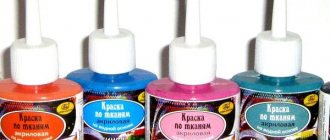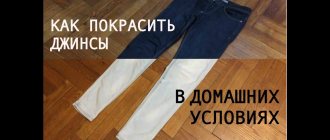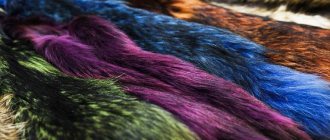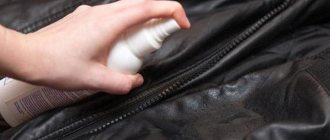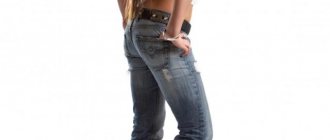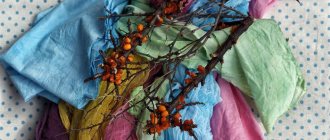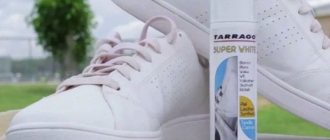Nuances of home coloring: expectations and reality
Changing the color of denim on your own is not easy. A number of actions will need to be performed, none of which can be ignored. Therefore, if you are not confident in your abilities, it is better to turn to specialists. Have you decided to act independently? Then, so that the final result does not disappoint, you need to take into account the following nuances.
First of all, they look at the composition of the fabric. Uniform coloring should be expected only if the proportion of cotton in it is at least 80%. If the percentage of synthetic fibers (for example: lavsan or polyester) reaches 30-40%, the pants will have scars and stripes. The fact is that artificial threads can only be dyed with special dyes, which are not suitable for cotton.
Please note that the contrast stitching on the pockets and side seams will most likely not be dyed either, as they are made using artificial threads.
The second step is to compare the original color of the product and the desired final result:
- The shade “as in the picture” can only be obtained when dyeing white trousers. The exception is black. White jeans will take on a dark gray color, but a “radical” black color is unlikely to be achieved.
- The dye always interacts with the original dye of the thing. For example, if you dip green jeans in black dye, they will turn olive, and red jeans will turn reddish brown.
- The best results can be expected when coloring a faded product with the same or even darker dye. So, black jeans can be obtained by immersing a product made of gray, blue, brown or faded black denim in a dyeing composition. The more concentrated the solution, the richer the color.
The third step is to conduct testing. Before you start dyeing jeans at home, you need to make sure that the chosen dye will give the desired effect. To do this, you should first experiment with a scrap of denim. If the result is satisfactory, you can start painting the item. If not, change the concentration of the prepared solution or prepare a new one.
A wet product always looks much darker than a dried one, so you need to evaluate the quality of the paint only after drying.
Preparatory stage
If you plan to restore the brightness of faded jeans, partially or completely repaint them in a different color, or hide scuffs, you cannot do without preliminary preparation of the product. To do this, you need to take the following steps:
- Weigh the jeans when dry. This is necessary in order to further understand how much dye is required.
- Turn the pockets inside out, remove any items remaining in them, and clean out any loose dust from the seams.
- Is the item worn? It needs to be inspected for dirt (greasy). If you find any, be sure to remove oil stains from the jeans, otherwise you won’t be able to get an even color.
- Wash trousers without using rinse conditioner. Rinse the treated item especially thoroughly, first in warm and then in cold water.
- Lightly wring out the pants, turn them inside out and smooth out all the folds and creases with your hands. If this is not done, streaks and spots will appear on the product after dyeing. Then immediately start painting.
New jeans should be immersed in hot water with soap shavings and washing soda dissolved in it (50 g and 30 g, respectively, per 10 liters) and boil for half an hour. This measure will help remove starch from the fibers remaining from factory processing, which may prevent the dye from penetrating properly into the fibers.
When you need to repaint a thing of a saturated shade, it must first be bleached. For this, soaking for 30-60 minutes in one of the hot compositions is suitable:
- in an aqueous solution of laundry soap, ammonia and soda ash (1 part of each component to 10 parts of water);
- in a solution of hydrosulfite (2 tbsp per 10 l);
- in water with bleach (1 liter of strained solution (10-15 g of substance per 1 liter of cold water) per 10 liters).
Hydrosulfite and bleach emit vapors harmful to the body, so during bleaching the container must be covered with film and the windows opened. Respiratory tract and hands should also be protected.
Preparing jeans for dyeing
Before you paint your jeans, you need to prepare them so that the paint goes on evenly:
- Take out small change from your pockets: coins, candy wrappers, pieces of paper, etc.
- Wash the item at a temperature of 40°C, in the “Jeans” or “Quick 30” mode, preferably with gel and conditioner. You can also use powder, but only as a last resort. The product must be turned right side out.
- Determine the weight of the clothes in order to correctly calculate the required volume of water and the amount of dye.
This will be enough if the jeans are white or light blue.
Dark things (black, blue, burgundy or gray) must be discolored as much as possible. To do this, you need to boil them as follows:
- Pour water into a saucepan that is the right size for the item.
- Add white in a ratio of 1:10, mix.
- Bring the solution to a boil.
- Reduce heat and place jeans in pan.
- Stirring the product periodically with a wooden spatula, cook it for half an hour or an hour until it becomes several tones lighter.
- Turn off the stove, drain the water and bleach, and rinse the pan thoroughly.
- Rinse slightly cooled jeans in clean water.
- Wash the trousers again, again at 40°C, but without powder, to remove any remaining bleach.
- There is no need to dry your jeans, you just need to squeeze out the excess moisture.
Attention! During the bleaching process, some things may turn yellow, this is normal, the yellowness will go away after the procedure is completed.
Selection of colorant
You can refresh or update the color of denim using synthetic or natural dyes. Let's look at this issue in more detail. Among the chemicals that can stain cotton are:
- Liquid and powder aniline dyes for fabric, for example: “Jeans” series dyes for hand and machine dyeing. Their advantages: color variety, good mixability with each other, low price.
- Powder dyes of varying degrees of stability and intensity, for example: “DYLON”, “Marabu Fashion Color”, “Anles”.
- Blue. The substance can make the color of denim quite uniform and rich, but it will last until the first wash. After using an alkaline cleaning solution, painting will have to be repeated. In addition, the product can only turn jeans that have faded blue.
- Hair dye. Of course, using it for fabric is one of the life hacks. However, high-quality products give good and lasting results.
You can refresh the color of your jeans using natural dyes, for example: herbal infusions, strongly brewed tea and coffee, infused onion peels, and turmeric. But these products penetrate denim fibers very poorly and give, rather, an additional shade rather than a new color, namely:
- turmeric – creamy;
- cinnamon – creamy with pink haze;
- onion peel - sandy;
- tea, oak bark, coffee – brown of varying degrees of intensity.
When choosing a coloring agent, you need to consider:
- How often will the product be washed and exposed to direct sunlight? If jeans are intended for daily wear, it is better to avoid using cheap, unstable dyes.
- What is the weight of the amount of powder in the bag? Perhaps one package will not be enough.
- There is always a danger that the color of the desired saturation will not be obtained the first time, and the procedure will have to be repeated twice. Therefore, you must always have a bag or jar of dye “in reserve.”
Where to begin?
In Soviet times, the range of clothing was not particularly diverse, so for our grandparents such a procedure as dyeing pants with their own hands was par for the course. Reliable and inexpensive means - blue and white - helped to stand out. It was then that the word “varenki” appeared, which was used to describe fashionably bleached jeans.
Modern clothing stores do not know the word “shortage”; you can find jeans in any colors and textures, with or without decoration. But even today, many needlewomen are happy to use grandmother’s proven recipes, wanting to extend the life of their favorite pants, with which they have gone through both fire and water.
So, how to dye jeans yourself? First of all, two questions need to be resolved:
- How can you dye jeans?
- How to do this - manually or using a washing machine?
Let's look at each of them in more detail.
Cold dyeing method
The cold method of dyeing jeans is the easiest to perform. It is especially relevant if it is not possible to purchase a special dye, for some reason it is impossible to do this in an automatic machine, or you do not want to stand near a hot stove.
What you will need
For it you will need:
- large (unnecessary) stainless steel or enamel-coated container;
- plastic or rubber gloves;
- small container made of plastic or glass;
- wooden or plastic spoon.
The nuances of cold dyeing depend on the type of dye. Here is the sequence of working with different types of dyes.
Blue
The easiest way to dye jeans blue is to use methylene blue. You need to do this:
- Fill the container with water and begin to gradually pour blue into it, stirring the solution periodically.
- When the color saturation of the solution seems satisfactory, add food or Glauber's salt (1 tablespoon per 3 liters) as a fixative.
- The wet product is immersed in the resulting mixture for 2 hours (during this time the jeans need to be turned over several times), then rinsed in several waters.
- Water for the last rinse is mixed with vinegar (1 tbsp per 1 liter) so that the products shed less.
Hair dye
Dye your jeans black, and also give them unusual shades with hair dye. The product is prepared in a glass container, stirring the concentrate with a non-metallic spoon, then, stirring, add to warm water until the required tone is obtained. The product is kept in the solution for 1.5 hours, then rinsed in a fixative and washed.
The dye can be applied directly to the fabric using a brush and then rinsed off, just like when dyeing hair.
Industrial dyes
Some industrial dyes, for example: DYLON, also act on fabric in cold water. The paint is dissolved separately, according to the instructions, then added to a bowl of water along with 5 tbsp. l. salt.
The dyeing time for jeans is 1 hour. During the first quarter of an hour, the product must be turned over frequently. In the remaining time, its position is changed only a few times. Dyed denim is rinsed and washed, as in the previous case.
In order for the dye to dissolve more efficiently, the water in the container is softened with baking soda or ammonia (1 tsp or 1 tbsp per 10 liters of water, respectively).
Textile dyes
The purchased product should be dissolved in a sufficient amount of water. The next procedure is as follows:
- Jeans soaked in it must be put on fire to boil. The duration of the procedure is at least an hour.
- To ensure uniform dyeing, the pants must be turned over frequently.
- Rinsing should also be done with vinegar and salt, after which the jeans should be dried.
Pants made from this material can be easily refreshed at home. The main thing is to choose the right tool and get your hands on a few unnecessary things.
Hot way
You can also dye jeans manually by boiling them in a dye solution. First of all, denim is processed in this way with aniline and most other powder dyes.
For this method you will need the same equipment as for cold dyeing. In addition, you need to stock up on wooden tongs or two long sticks for turning the product over. The process of dyeing jeans occurs in the following sequence:
- Dissolve the dye in a glass container following the directions on the package. If necessary, filter the resulting mixture through cheesecloth so that there are no lumps that will prevent the paint from laying evenly.
- The prepared composition is poured into a container with water, baking soda (1.5-2 tbsp) is mixed into the solution. For denim in dark shades, you can add 2 tbsp. l. substances.
- The mixture is put on fire and wait until it reaches a temperature of 60°. If foam from soda forms on the surface, it must be removed.
- Wet jeans are dipped into the container and, periodically turning them with tongs or sticks, heated for about half an hour.
- Add 2-5 tbsp to the solution. l. salt to deepen the color and increase the heat, bringing the water to a boil.
- Light jeans are boiled for half an hour, dark jeans are boiled for 15-30 minutes longer, black jeans are boiled for up to an hour and a half.
- When the specified time has passed, turn off the fire and let the item lie in the solution for about a quarter of an hour.
- Then the jeans are rinsed. The water should be changed until it stops being colored. During the last rinse, vinegar is added to the basin.
When dyeing cotton in dark colors, the ratio of the weight of the product and the volume of liquid should be 1:20, in light colors - 1:30 or 1:40.
photo: depositphotos.com/ivan_dzyuba
Digestion is also used when processing cotton with natural dyes. Here are a few recipes as an example:
- Henna is diluted according to the instructions in a ceramic bowl, dissolved in hot water and trousers are boiled in it for half an hour.
- Add cinnamon (ground coffee or tea leaves) to hot water (2 tablespoons per 1 liter) and bring the mixture to a boil. The fabric is boiled in the solution for 10 minutes.
- Dry onion peels (4 handfuls per 1 liter of water) are boiled for a quarter of an hour, then a cloth is placed in a container and heating is continued for another 10-15 minutes.
After final processing, the jeans should be immediately hung on a line to dry. If you leave them in the basin, unwanted stains may appear on the denim.
What and how to dye black jeans to update their color?
To restore the faded color of black jeans, it is not necessary to use a profile dye; you can limit yourself to hair dye. For trousers of standard sizes, at least two packages of the product are required, but it is better to purchase the composition with a reserve. We simply dilute the active component in warm water in a basin, immerse the jeans in the composition for at least an hour, and take it out.
The product must be rinsed thoroughly in plain water, then soaked in a mixture of water, vinegar and table salt for a couple of minutes, this will fix the color. All that remains is to dry the product and evaluate the result of the work.
If you use fabric dye to restore the color of jeans, then you cannot do without boiling. The process is simple: dilute the mixture, soak the trousers, put the container on the fire and boil the product, stirring constantly, for an hour and a half.
It is important to understand that if technical recommendations are neglected, there is a risk of obtaining the most unexpected and not always pleasant result. https://www.youtube.com/embed/9X2QNw1Opwg
Dyeing in the washing machine
Most synthetic dyes are suitable for dyeing fabric in an automatic machine. Depending on the type of chemical product, this method of updating the color of jeans has its own nuances, but the general rules for dyeing are as follows:
- The wet garment is loaded into the drum along with dye and salt. In some cases, the paint is pre-diluted, in others it is left dry and placed in the car along with the bag. Sometimes there is no need to add salt (for example, Simplicol paints already have it).
- The panel sets the temperature acceptable for the fabric. Usually 60-80°, but sometimes 40° is enough.
- The jeans are dyed in the cotton mode and then a double rinse is used.
- Powder for colored fabrics is poured into the cuvette of the device and a normal wash is performed. To consolidate the effect, you can pour 50-100 g of table vinegar into the conditioner container.
It is not recommended to dye jeans in a machine with aniline dyes, as in this case the color turns out paler than when dyed by hand.
How to save the result
Dyed denim requires special treatment. How to properly care for these products:
- Wash in warm water, temperature no higher than 40 degrees.
- We recommend manual wet cleaning or machine cleaning on a delicate cycle.
- The best detergent is dark laundry soap. Soap shavings are prepared for machine washing.
- Dyed jeans are washed separately from other items.
- It is advisable to avoid air conditioning.
When analyzing the details, it turns out that dyeing jeans at home is not a difficult process, and the materials are generally cheap. All that is required from the needlewoman is attentiveness, caution when working with hot solutions and a willingness to take risks.
Creative Denim Processing Options
If you want to create original jeans, you need to dye them differently. There are several types of creative processing of products:
Uneven coloring
In order for original stripes of various types to appear on jeans, they can be processed in two ways:
- Wet it, twist it into a tourniquet and tie it in different places with rubber bands. In this form, immerse in a basin and paint using a cold or hot method.
- Remove all metal accessories from your pants, including the zipper. Then tie the legs in knots several times or crease along the entire length. Dissolve the paint in a fireproof glass container and place the trousers in it. Wrap the container on all sides with cellophane and place in the microwave for 4 minutes. Then the item of clothing is washed and rinsed without untying. Straighten the product only during drying.
Applying color stripes
Aniline dyes will help make jeans fully or partially multi-colored. They paint on damp fabric with a brush in different ways:
- To create the effect of shimmering colors, paints are applied immediately, overlapping each other in places.
- To clearly differentiate the colored areas, the liquid pigment is mixed with tragacanth glue in a ratio of 1:3 or the painted jeans are soaked in gelatin dissolved in water (2-3 crystals per 1 liter).
- Drawn prints. To apply designs of various colors and sizes to denim, acrylic or plastisol paints are used. They are applied to a dry, clean cloth, pre-stretched on thick cardboard. First, paint over the light details of the template, then the dark ones. After 15 hours, the fabric is ironed from the wrong side for several minutes, and then from the front through gauze.
It is not advisable to go for a walk in the cold wearing hand-painted items. It is better to wash re-dyed fabrics with laundry soap in a basin.
As you can see, to give jeans a second life, you don’t have to wait until they fade. With the right approach, using paint, you can create a completely original thing from an ordinary model.
Plastisol paints
They are more often used in screen printing, but for manual work there is a fluorescent dye based on a phosphor.
- Jeans are cleaned of dirt and washed.
- The first layer of the image is applied with a synthetic brush.
- After the first layer has completely dried, the second and subsequent layers are applied.
- After applying the last layer, the jeans dry for 2-3 hours.
To make the drawing look more impressive, light colors are used as a basis. The glow dye is charged from sunlight, which accumulates in 20-30 minutes.

